ms-63
1888, Russia, Emperor Alexander III. Beautiful Gold 5 Roubles Coin. PCGS MS-63
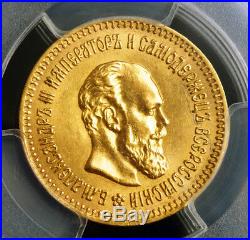
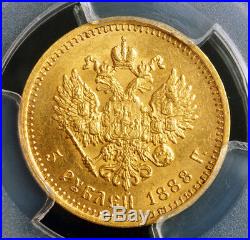
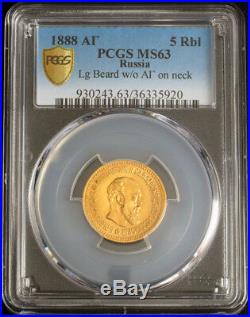
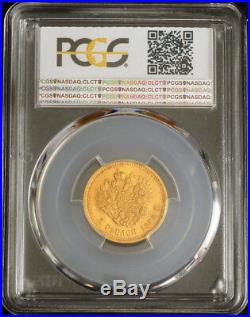

1888, Russia, Emperor Alexander III. Beautiful Gold 5 Roubles Coin. Mint Year: 1888 Denomination: 5 Roubles Mint Place: St. Petersburg Mint Master: Appolon Grasgov (AG) Reference: Friedberg 168, KM-42. Certified and graded by PCGS as MS-63! 1867 AGW Diameter: 21mm Weight: 6.44gm. Obverse: Bearded head on Alexander III right. Alexander III Emperor and Sole Ruler of all Russians. Reverse: Heraldic eagle with shields of provinces (duchies), holding imperial orb and staff. 5 Robules 1888 Year. Alexander III Alexandrovich 10 March O. 26 February 1845 1 November O. 20 October 1894 (Aleksandr III Aleksandrovich) reigned as Emperor of Russia from 13 March 1881 until his death in 1894. Unlike his assassinated father, liberal-leaning Alexander II, Alexander III is considered by historians to have been a repressive and reactionary tsar. Alexander III was born in Saint Petersburg, the second son of Czar Alexander II by his wife Princess Marie of Hesse and by Rhine. In disposition, he bore little resemblance to his soft-hearted, liberal father, and still less to his refined, philosophic, sentimental, chivalrous, yet cunning granduncle Alexander I, who coveted the title of “the first gentleman of Europe”. Although an enthusiastic amateur musician and patron of the ballet, he was seen as lacking refinement and elegance. Indeed, he rather relished the idea of being of the same rough texture as the great majority of his subjects. His straightforward, abrupt manner savoured sometimes of gruffness, while his direct, unadorned method of expressing himself harmonized well with his rough-hewn, immobile features and somewhat sluggish movements. His education was not such as to soften these peculiarities. He was also noted for his immense physical strength, though the large boil on the left side of his nose caused him to be severely mocked by his contemporaries, hence why he always sat for photographs and portraits with the right side of his face most prominent. During the first twenty years of his life, Alexander had little prospect of succeeding to the throne, because he had an elder brother, Nicholas, who seemed of robust constitution. Even when this elder brother first showed symptoms of delicate health, the notion that he might die young was never seriously taken; Nicholas was betrothed to the Princess Dagmar of Denmark. Under these circumstances, the greatest solicitude was devoted to the education of Nicholas as Tsarevich, whereas Alexander received only the perfunctory and inadequate training of an ordinary Grand Duke of that period, which did not go much beyond secondary instruction, with practical acquaintance in French, English and German, and a certain amount of military drill. Alexander became heir apparent by the sudden death of his elder brother in 1865. It was then that he began to study the principles of law and administration under Konstantin Pobedonostsev, who was then a professor of civil law at Moscow State University and who later (in 1880) became chief procurator of the Holy Synod. Pobedonostsev awakened in his pupil very little love for abstract studies or prolonged intellectual exertion, but he influenced the character of Alexander’s reign by instilling into the young man’s mind the belief that zeal for Russian Orthodox thought was an essential factor of Russian patriotism and that this was to be specially cultivated by every right-minded Tsar. On his deathbed, Alexander’s elder brother Nicholas is said to have expressed the wish that his affianced bride, Princess Dagmar of Denmark, should marry his successor. This wish was swiftly realized, when on 9 November O. 28 October 1866 in the Imperial Chapel of the Winter Palace in St. Petersburg, Alexander wed the Princess of Denmark. The union proved a most happy one and remained unclouded to the end. Unlike that of his parents, there was no adultery in the marriage. During those years when he was heir-apparent1865 to 1881Alexander did not play a prominent part in public affairs, but he allowed it to become known that he had certain ideas of his own which did not coincide with the principles of the existing government. Alexander deprecated what he considered undue foreign influence in general, and German influence in particular, so the adoption of genuine national principles was off in all spheres of official activity, with a view to realizing his ideal of a homogeneous Russiahomogeneous in language, administration and religion. With such ideas and aspirations he could hardly remain permanently in cordial agreement with his father, who, though a good patriot according to his lights, had strong German sympathies, often used the German language in his private relations, occasionally ridiculed the exaggerations and eccentricities of the Slavophiles and based his foreign policy on the Prussian alliance. The antagonism first appeared publicly during the Franco-Prussian War, when the Tsar supported the cabinet of Berlin and the Tsarevich did not conceal his sympathies for the French. It reappeared in an intermittent fashion during the years 18751879, when the Eastern question produced so much excitement in all ranks of Russian Society. At first the Tsarevich was more Slavophile than the government, but his phlegmatic nature preserved him from many of the exaggerations indulged in by others, and any of the prevalent popular illusions he may have imbibed were soon dispelled by personal observation in Bulgaria, where he commanded the left wing of the invading army. After many mistakes and disappointments, the army reached Constantinople and the Treaty of San Stefano was signed, but much that had been obtained by that important document had to be sacrificed at the Congress of Berlin. Bismarck failed to do what was confidently expected of him by the Russian Tsar. In return for the Russian support, which had enabled him to create the German Empire, it was thought that he would help Russia to solve the Eastern question in accordance with her own interests, but to the surprise and indignation of the cabinet of Saint Petersburg he confined himself to acting the part of “honest broker” at the Congress, and shortly afterwards he ostentatiously contracted an alliance with Austria for the express purpose of counteracting Russian designs in Eastern Europe. The Tsarevich could point to these results as confirming the views he had expressed during the Franco-Prussian War, and he drew from them the practical conclusion that for Russia the best thing to do was to recover as quickly as possible from her temporary exhaustion and to prepare for future contingencies by a radical scheme of military and naval reorganization. In accordance with this conviction, he suggested that certain reforms should be introduced. The item “1888, Russia, Emperor Alexander III. Beautiful Gold 5 Roubles Coin. PCGS MS-63″ is in sale since Sunday, December 30, 2018. This item is in the category “Coins & Paper Money\Coins\ World\Gold”. The seller is “coinworldtv” and is located in Europe. This item can be shipped worldwide.
- Certification Number: 36335920
- Certification: PCGS
- Grade: MS63
- Composition: Gold
- Year: 1888

1874, Russia, Emperor Alexander II. Rare Gold 5 Roubles Coin. Gem! PCGS MS-63
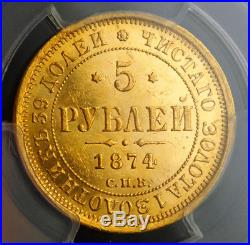
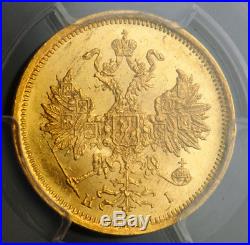
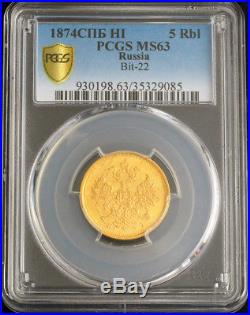
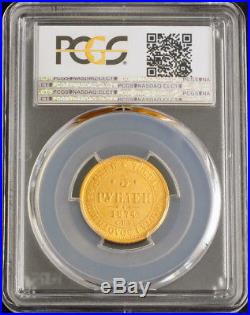

1874, Russia, Emperor Alexander II. Rare Gold 5 Roubles Coin. Mint Year: 1874 Denomination: Gold 5 Roubles Mint Place: St. Certified and graded by NGC as MS-63 only three equal graded at PCGS and only one higher at MS64! 917 Weight: 6.54gm. Obverse: Large value numeral (5), flanked by rosettes. Denomination (“ROUBLES”), arabesques, date (1874) and mint initials… PURE GOLD 1 ZOLOTNIK 39 DOLS. Reverse: Large crown above crowned double-headed eagle, holding imperial scepter and orb. Mint master`s H-I initials below. 17 April 1818 in Moscow 13 March O. 1 March 1881 in Saint Petersburg was the Emperor of Russia from 2 March 1855 until his assassination in 1881. He was also the King of Poland and the Grand Duke of Finland. Alexander’s most significant reform as emperor was emancipation of Russia’s serfs in 1861, for which he is known as Alexander the Liberator. The tsar was responsible for other reforms, including reorganizing the judicial system, setting up elected local judges, abolishing corporal punishment, promoting local self-government through the. System, imposing universal military service, ending some privileges of the nobility, and promoting university education. He sought peace, moved away from bellicose France when Napoleon III fell in 1871, and in 1872 joined with Germany and Austria in the League of the Three Emperors that stabilized the European situation. Despite his otherwise pacific foreign policy, he fought a brief war with Turkey in 187778, pursued further expansion into Siberia and the Caucasus, and conquered Turkestan. Although disappointed by the results of the Congress of Berlin in 1878, Alexander abided by that agreement. Among his greatest domestic challenges was an uprising in Poland in 1863, to which he responded by stripping that land of its separate constitution and incorporating it directly into Russia. Alexander was proposing additional parliamentary reforms to counter the rise of nascent revolutionary and anarchistic movements when he was assassinated in 1881. The item “1874, Russia, Emperor Alexander II. Rare Gold 5 Roubles Coin. Gem! PCGS MS-63″ is in sale since Friday, July 6, 2018. This item is in the category “Coins & Paper Money\Coins\ World\Gold”. The seller is “coinworldtv” and is located in Europe. This item can be shipped worldwide.
- Certification Number: 35329085
- Certification: PCGS
- Grade: MS63

7-Coin $20 Saint-Gaudens Gold Double Eagle Date Set MS-63 NGC SKU#163239
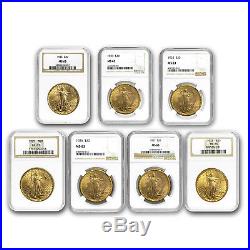
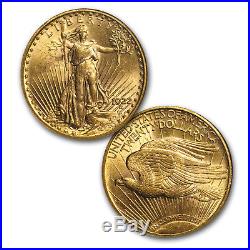
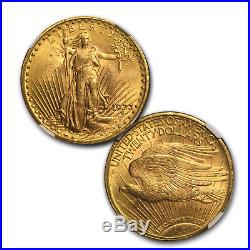
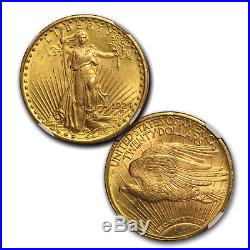
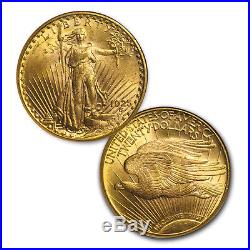
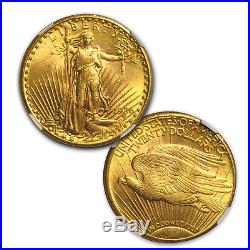
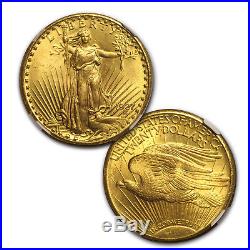
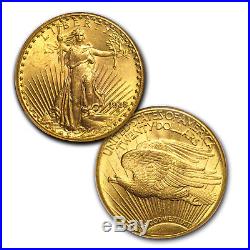

1 oz Gold Bars. 1 oz lot of 20. 1 oz lot of 25. 1 oz lot of 100. 1 oz lot of 500. 9675 oz of Gold per coin. NGC encapsulation authenticates and protects the condition of each coin. Each set is attractively housed in a NGC slab holder box. Obverse: Shows Lady Liberty striding in front of the sun’s rays with a fiery torch in her right hand and an olive branch in her left. Reverse: Features a majestic bald eagle in flight with “United States of America” and “Twenty Dollars” above. Mint issue from the following mint: Philadelphia. Protect your Saint-Gaudens Double Eagle in style by adding an attractive display box. NGC, one of the top two coin grading services, has guaranteed the Mint State-63 condition of these coins, adding collectibility to the beloved design. Contains (1 each) of the following dates: 1922, 1923, 1924, 1925, 1926, 1927 & 1928. Each package is fully insured. There are no exceptions to this rule. The UPS Store, or similar third party drop off locations. If you do not receive the package directly from the common carrier, you agree to take all reasonable actions to assist in recovery of the package, including but not limited to filling out reports (and/or police reports) and providing all information needed or that may be requested to assist in recovery of the package. We may ask you to file a police report if it appears loss is due to theft or tampering. Your assistance speeds up the investigation and the sooner we complete it, the sooner we can resolve the missing order. If we determine the package is lost or damaged, we file a claim. Failure to fully cooperate will jeopardize coverage that may be provided to you. For approved exchanges, you must follow all instructions provided by Customer Service, including carefully packaging the Product. Prices Q: How often are prices updated? Our listings remain live while pricing updates so you don’t have to worry about listings being removed and reposted. Orders Q: Is there a minimum order amount? Orders of all dollar amounts are welcome. Q: Can I change my order once it’s placed? A: Processing begins immediately upon completion therefore changes cannot be accepted. Q: Can I cancel my order? A: Once your order is completed it cannot be cancelled. Please be certain of your order before finalizing. A: Oklahoma City, Oklahoma. Q: Is my package insured while in transit? Additionally, if a package is signed for by the apartment/complex building management, we do not assume responsibility. Q: What do I do when my package appears to be lost? There are no added commissions. Back Ordered Items Supply and demand problems occasionally occur in our business. From time to time, we have more buyers than sellers. If your Order(s) is cancelled, you agree you have full responsibility and liability to APMEX for any Market Loss. Pricing or Typographical Errors We work hard to provide accurate Product and pricing information to you. However, pricing or typographical errors may occur. Prices and availability are subject to change without notice. Risks All investments involve risk; Coins and Bullion are no exception. The value of a Bullion Coin e. American Eagles or Canadian Maple Leafs is affected by many economic factors, including the current market price of Bullion, the perceived scarcity of the Coins and other factors. Some of these factors include the quality, and current demand and general market sentiment. Therefore, because both Bullion and Coins can go down in price as well as up, investing in them may not be suitable for everyone. Because all investments, including Bullion and Coins, can decline in value, you should understand them well, and have adequate cash reserves and disposable income before considering a Bullion or Coin investment. Please consult your financial advisor. APMEX does guarantee that every item that we sell is genuine and that all Precious Metal items do contain the weight, fineness, and purity that we have advertised. However, all investments, of every type, involve some level of risk and Precious Metals are no exception. Like many markets, the Precious Metals market is speculative, and it is unregulated. The value of any Bullion item is generally determined by current spot price of the underlying Precious Metal and by the supply and demand for these particular items. These prices will fluctuate throughout the day while the Precious Metals market is open. If you are considering purchasing Precious Metals as an investment, you should assess the stability of the current market and contact your financial advisor for all advice. Definitions The following terms have the following meanings in these T&C: 1. The term “APMEX” means APMEX, Inc. The term “Bullion” is used to describe (1) Gold, Silver, Platinum or Palladium Coin(s) which closely follow spot prices and have little or no Numismatic value (such as restrikes); and (2) the form in which metal is shaped such as bars, ingots or wafers. The term “Coin(s)” means a stamped piece of metal of a known weight and fineness issued for commerce by a sovereign government. The term “Fair Market Value” means the Fair Market Value of the Product as determined by APMEX, in its reasonable discretion, as of 5:00 p. The term “Numismatic Coin(s)” means a Coin, the price of which depends more in its (their) rarity, condition, dates, and mint marks than on their gold or silver content, if any. The term “Precious Metal” means Gold, Silver and Platinum along with the Platinum group of elements: rhodium, osmium, ruthenium, Palladium and iridium. Precious Metals are characteristically lustrous, ductile, rare and nonreactive. The term “Semi-Numismatic” means a Coin that has both Bullion and Numismatic value. General Absence of Relationship. No other relationship, including, without limitation, any agent-principal relationship, any employee-employer relationship, any franchisee-franchisor relationship, any joint venture relationship or any partnership relationship, between APMEX and you exists. You may not assign any of your rights or obligations under these T&C without the prior written consent of APMEX, which may be granted or withheld by APMEX in its sole discretion. This contract, including but not limited to the T&C, shall be binding on all permitted assigns and successors of APMEX and you. It is APMEX’s goal that any disagreement or dispute be resolved expeditiously. If an amicable resolution cannot be reached, you agree that any and all disagreements and disputes between us shall be resolved in accordance with the following paragraphs: (a) Forum Selection and Governing Law. All such disputes shall be resolved exclusively in such federal and state courts, as appropriate, in that jurisdiction. You hereby consent to personal jurisdiction and venue in those federal and state courts for the purpose of resolving any disagreements or disputes between us and waive all objections to the jurisdiction of such federal and state courts. Any action arising out of or relating to these T&C shall be governed by, and interpreted in accordance with, the laws of the State of Oklahoma, without regard to conflict of laws principles. (b) Waiver of Jury Trial; Arbitration. If APMEX cannot perform any obligation hereunder as a result of any event that is beyond its control, APMEX’s delay or failure to perform such obligation shall be excused and APMEX shall not be liable for any damages as a result of, or in connection with, such delay or such failure. You shall execute and deliver such other documents and take such other actions as may be reasonably requested by APMEX to carry out your obligations under these T&C. Except as otherwise provided herein, all notices and other communications to APMEX shall be directed to APMEX, c/o Chief Financial Officer, 226 Dean A. McGee Avenue Oklahoma City, OK 73102, and all other notices and other communications to you shall be directed, at the option of APMEX, to the address that you provided to APMEX at the time of your registration. A decision or a failure by APMEX to take action with respect to any non-compliance by you of your obligations to APMEX or to insist upon strict adherence to any term in these T&C, does not affect the ability of APMEX with respect to any other non-compliance by you, and does not waive or limit APMEX’s right thereafter to insist upon strict adherence to that or any other term, whether of a similar or dissimilar nature. The section headings are included for ease of reference and do not affect the interpretation or the scope of these T&C. These T&C are intended to be enforceable to the fullest extent permitted by applicable law. If any term of these T&C is held to be unenforceable for any reason, such unenforceability shall not affect the other terms of these T&C, and the term that would otherwise be unenforceable shall be enforced to the fullest extent that it would be enforceable. APMEX may amend these T&C at any time by posting the amended terms on the website, and such amendments shall become effective immediately. If you become aware that you may be required to make any disclosure of such information, including, without limitation, as a result of the receipt of a subpoena or other compulsory process, you shall promptly notify, in writing, APMEX and you shall cooperate, in good faith, with APMEX in obtaining a protective order or other appropriate relief, if any, with respect to such disclosure. The item “7-Coin $20 Saint-Gaudens Gold Double Eagle Date Set MS-63 NGC SKU#163239″ is in sale since Monday, February 19, 2018. This item is in the category “Coins & Paper Money\Coins\ US\Gold (Pre-1933)\$20, Double Eagle”. The seller is “apmex” and is located in United States. This item can be shipped to United States.
- Brand: US Mint
- MPN: 163239
- Certification: NGC

1923, Egypt, King Fuad I. Scarce Gold 20 Piastres (1/5 Pound) Coin. NGC MS-63
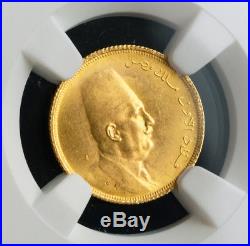
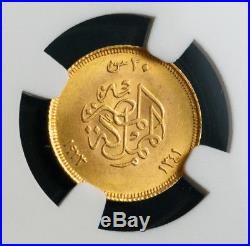
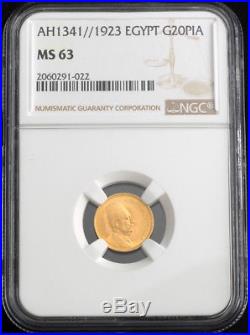
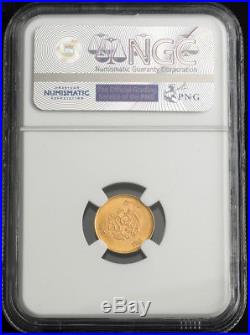

1923, Egypt, King Fuad I. Scarce Gold 20 Piastres (1/5 Pound) Coin. Mint Date: 1923 (AH 1341) Denomination: 20 Piastres (1/5 Pound) Condition. Certified and graded by NGC as MS-63! 875 Weight: 1.7gm. Obverse: Bust of King Fuad I of Egypt left, flanked by arabic legends. Reverse: Decortive medalion with Kufic inscriptions. Dual date (1929 / AH 1348) at sides. Fuad I (26 March 1868 – 28 April 1936), was the Sultan and later King of Egypt and Sudan, Sovereign of Nubia, Kordofan, and Darfur. The ninth ruler of Egypt and Sudan from the Muhammad Ali Dynasty, he became Sultan of Egypt and Sudan in 1917, succeeding his elder brother Sultan Husayn Kamil. He substituted the title of King for Sultan when the United Kingdom formally recognized Egyptian independence in 1922. Fuad struggled with his sister throughout his reign. In 1930, he attempted to strengthen the power of the Crown by abrogating the 1923 constitution and replacing it with a new constitution that limited the role of parliament to advisory status only. Large scale public dissatisfaction compelled him to restore the earlier constitution in 1935. Fuad was born in Giza Palace in Cairo, the seventh son of Isma’il Pasha. His mother was Farial Kadin. As a great-grandson of Muhammad Ali Pasha, Fuad was of Albanian descent. He married his first wife in Cairo, 30 May 1895 at the Abbasiya Palace in Cairo, 14 February 1896, H. She was his cousin and the only daughter of Field Marshal H. Prince Ibrahim Fahmi Ahmad Pasha. They had two children, a son, Ismail Fuad, who died in infancy, and a daughter, Fawkia. Unhappily married, the couple divorced in 1898. During a dispute with the brother of his first wife, Fuad was shot in the throat. He survived, but carried that scar the rest of his life. Fuad married his second wife at the Bustan Palace, Cairo, 26 May 1919. Abdu’r-Rahim Pasha Sabri, sometime Minister of Agriculture and Governor of Cairo, by his wife, Tawfika Khanum Sharif. Queen Nazli also was a maternal granddaughter of Major-General H. Muhammad Sharif Pasha, sometime Prime Minister and Minister for Foreign Affairs, and a great-granddaughter of Suleiman Pasha, a French officer in Napoleon’s army who converted to Islam and reorganized the Egyptian army. The couple had five children, the future Farouk I and four daughters, the Princesses Fawzia (who became Queen Consort of Iran), Faiza, Faika, and Fathiya. As with his first wife, Fuad’s relation with his second wife was also stormy. The couple continually fought; Fuad even forbidding Nazli from leaving the palace. Fuad died at the Qubba Palace in Cairo and was buried at the Khedival Mausoleum in the ar-Rifai Mosque in Cairo. The item “1923, Egypt, King Fuad I. Scarce Gold 20 Piastres (1/5 Pound) Coin. NGC MS-63″ is in sale since Sunday, December 3, 2017. This item is in the category “Coins & Paper Money\Coins\ World\Gold”. The seller is “coinworldtv” and is located in Europe. This item can be shipped worldwide.
- Certification: NGC
- Certification Number: 2060291-022
- Grade: MS63
- Composition: Gold

- ← Previous
- 1
- 2